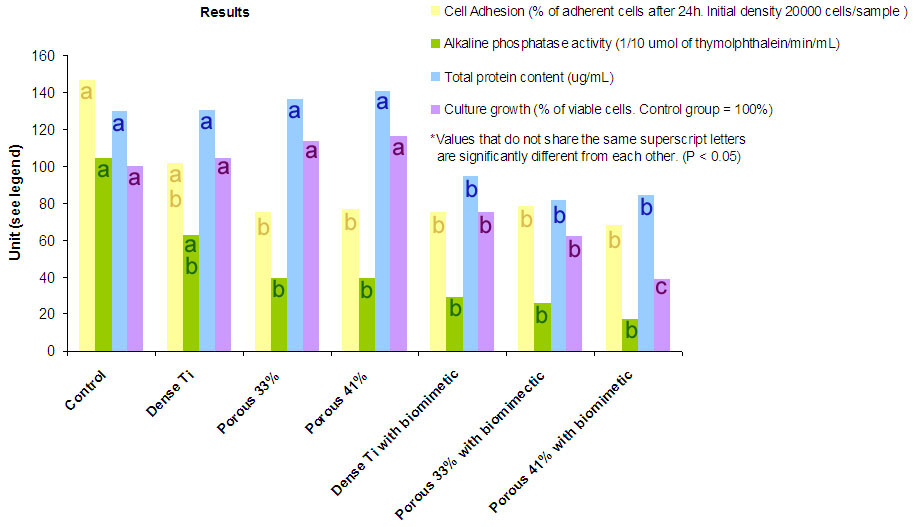Thursday, March 22, 2012: 2 p.m. - 3:15 p.m.
Presentation Type: Poster Session
R.F. PRADO1, F.S.D. OLIVEIRA
2, L.M.R. VASCONCELLOS
3, L.D.D. OLIVEIRA
2, Y. CARVALHO
4, and C.A.A. CAIRO
5,
1Bioscience and Buccal Diagnosis, University State Paulista, São Jose dos Campos, Brazil,
2Universidade Est. Paulista Julio Mesquita, São José dos Campos, Brazil,
3Bioscience and Buccal Diagnosis, Universidade Est. Paulista Julio Mesquita, São Jose dos Campos, Brazil,
4Oral Medicine & Pathology, Faculdade de Odontologia de São José dos Campos, UNESP, Sao Jose Dos Campos, Brazil,
5Division of Materials - CTA, São Jose dos Campos, Brazil
Objectives: The
experiment aimed to evaluate in vitro
osteogenesis comparing cell behavior after contact with
titanium samples of different porosities with/without biomimetic
treatment. Methods: Porous Ti discs
were fabricated by the powder metallurgy process and divided into seven groups: a)Control: well's
plate (C), b)dense titanium sample (Ti), c)sample with 33% of porosity (33%), d)samples
with 41% of porosity (41%), e)dense Ti-sample with biomimetic
treatment (TiB),
f)sample with 33% of porosity with biomimetic treatment (30%B) and g)samples with 41% of porosity with biomimetic
treatment (41%B). The biomimetic
coating was done with alkali (NaOH) treatment, followed
by heat treatment at 200°C
and submersion of samples in modified simulated body fluid, changed every 48h,
for 14 days. Osteoblastic cells were isolated, by
sequential enzymatic digestion of explants, from healthy
human alveolar bone. It was done in accordance to Ethical
Principles, in triplicate and cells grew until subconfluence with supplemented
a-Minimum Essential Medium. Then, cells
were subcultured in 24-well culture plates on each group sample at a
cell density of 2x104 cells/sample, for periods of up to 14 days. Adhesion test was done after 24
hours with count in Newbauer chamber. The cell
viability was determinated by [(bromide
3-4.5-dimethylthiazol-2-yl)-2,5-difeniltetrazoliol] colorimetric assay. Total protein content was obtained by modified method
of Lowry and alkaline phosphatase activity was
accessed using a commercial kit. Results: ANOVA and Tukey tests showed
that adherent cells percentage and alkaline phosphatase
activity were similar in titanium samples apart of porosity and presence of biomimetic coating (Graphic). However, phosphate hydroxide
deposition in samples with biomimetic treatment
reduced the total protein content and the viability of the tested cells. Conclusion:
Analyzing the behavior of cells based on the results it was concluded that biomimetic treatment impaired the biocompatibility of titanium.
Graphic – In vitro effects of porosity and biomimetic
treatment in titanium samples

This abstract is based on research that was funded entirely or partially by an outside source: State of São Paulo Research Foundation (FAPESP)
Keywords: Biocompatibility, Cell culture, Implants, Metals and Osteoblasts/osteoclasts
![[ Visit AADR's Website ]](images/banner.jpg)
